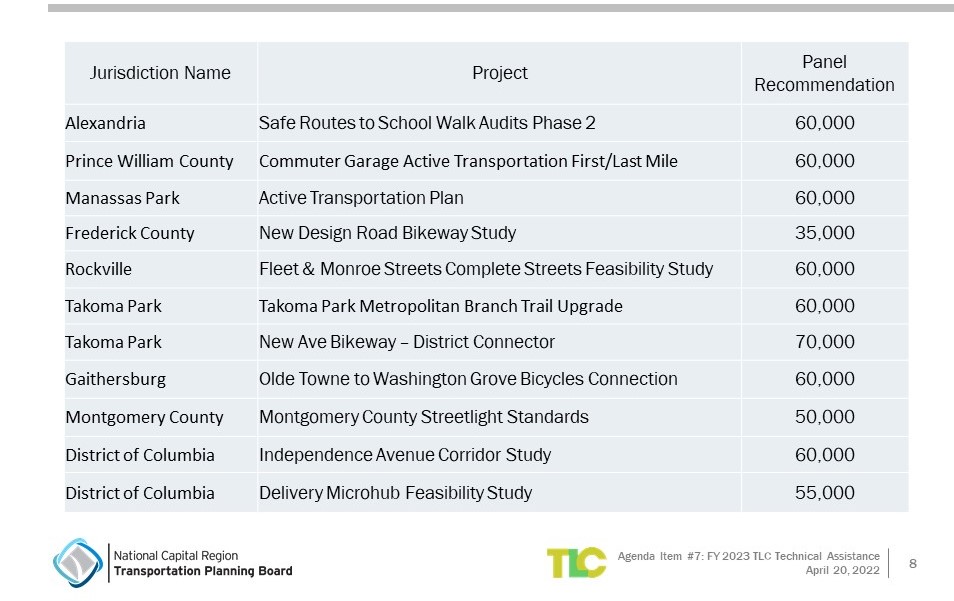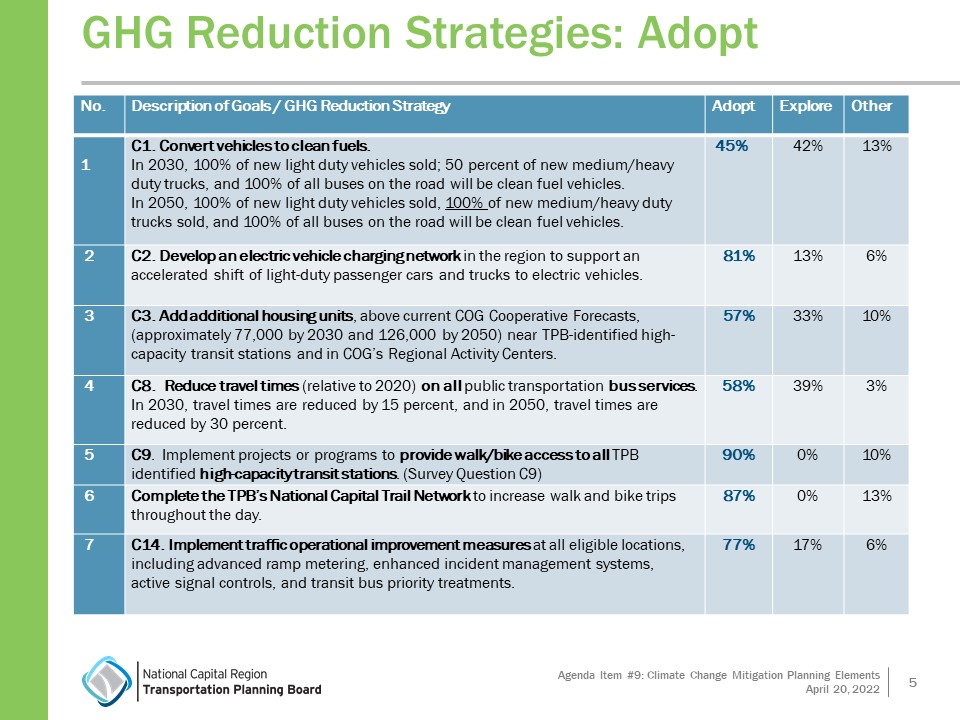At the April 20 meeting, the TPB approved 11 projects for Transportation Land-Use Connections (TLC) Program funding, received a report on the Climate Change Mitigation Goals and Strategies survey results, and heard an overview of Visualize 2045, the draft long-range transportation plan update. In addition, the TPB recognized Bob Brown, Loudoun County TPB alternate as well as active member and former chair of the TPB Technical Committee, on his service to the TPB and his upcoming retirement.
April 20 meeting agenda, materials, and recording
FY 2023 Transportation Land-Use Connections (TLC) Program Projects
Julia Koster, National Capital Planning Commission Office of Public Engagement Director, who serves as chair of the Transportation Land-Use Connections (TLC) program grant panel, and John Swanson, TPB Transportation Planner, presented the District of Columbia, Maryland, and Virginia projects recommended for Fiscal Year 2023 funding through the TLC program.
“Even though these projects are awarded to individual jurisdictions, what they represent is an intentional commitment by the TPB as a regional body to advance the priorities that you care about: guiding growth to high capacity transit areas and activity centers, advancing equity, supporting a regional trail network, all in different communities all across the region. These are really the TPB’s projects,” Koster said.
TLC enhances local capacity, explores innovation, and does the work of teeing up smaller projects for future significant infrastructure opportunities.
As background, the TLC program has funded 156 short-term (eight to nine months) planning and design studies at the $30,000 - $80,000 level. The technical assistance projects cover a range of activities such as bicycle and pedestrian planning, corridor and small area planning, and development of analytical tools.
Twenty applications were received for Fiscal Year 2023, and the projects selected focus on connections within Activity Centers and connections to High-Capacity Transit Station Areas (HCTs), as well as Safe Routes to Schools. The total funding available in the region is $630,000. The TPB approved funding for 11 projects.
Three highlighted projects reflect the variety in how TLC funding is used:
- The District of Columbia will develop a feasibility study to address last-mile freight challenges to look at strategically locating staging areas or microhubs to facilitate sustainable delivery modes, including bicycle, cargo bicycle, and foot deliveries.
- Montgomery County will conduct a safety-related project to advance the county’s Vision Zero initiative and Complete Streets design guidelines by setting standards for corridor and intersection illumination in urban, exurban, and suburban parts of the county.
- The City of Manassas Park will prepare a bicycle and pedestrian Active Transportation Plan that will identify infrastructure opportunities within the municipal boundaries of Manassas Park but also making connections with the City of Manassas and Prince William County.
Table of FY 2023 TLC projects:

(Source: TPB)
Developing Climate Change Mitigation Goals and Strategies Specific to the Transportation Sector
With the TPB planning to take action on climate change mitigation goals and strategies that can be supported by the majority of TPB members, Timothy Canan, TPB Planning Data and Research Program Director, and Kanti Srikanth, TPB Staff Director, reported the results of a recent survey of TPB members designed to gain member input on greenhouse gas (GHG) reduction goals for the on-road transportation sector, climate change considerations in member jurisdictions’ transportation decision making, and adopting a set of GHG reduction strategies for the TPB’s transportation plan and planning process.
The following questionnaire results set the foundation for the TPB’s continuing discussion on climate change mitigation goal setting:
- 70 percent of responding TPB jurisdictions/agencies have multi-sector GHG reduction goals.
- 65 percent think that the TPB should adopt GHG reduction goals for the on-road transportation sector.
- Seven GHG reduction strategies were identified as having majority or plurality support by the survey respondents.
- Seven other GHG reduction strategies were identified as needing further exploration, since the survey did not identify strong support for this second set of strategies.
According to the results of the survey, TPB members indicated support for the following specific strategies for TPB discussion and potential adoption:
- Convert vehicles to clean fuels with 2030 and 2050 targets.
- Develop an electric charging network in the region.
- Add additional housing units near High-Capacity Transit Station Areas (HCTs) and in COG’s Activity Centers.
- Reduce travel times (relative to 2020) on all public transportation bus services.
- Implement projects or programs to provide walk/bike access to all TPB identified high-capacity transit stations.
- Complete the TPB’s National Capital Trail Network to increase walk and bike trips throughout the day.
- Implement traffic operational improvement measures at all eligible locations, including advanced ramp metering, enhanced incident management systems, active signal controls, and transit bus priority treatments.
Next steps – The TPB held an initial work session on April 20 with discussion focusing on the seven strategies above and plans to hold a second work session in May to talk about the levels of GHG reduction that TPB would like to adopt as targets.

(Source: TPB)
Visualize 2045 Update, FY 2023-2026 TIP and Air Quality Conformity Analysis
Stacy Cook and Sergio Ritacco, TPB Transportation Planners, and Eric Randall and Jane Posey, TPB Engineers, provided an overview of the draft plan update and accompanying materials. The Visualize 2045 update is currently in a 30-day comment period that runs through May 1, 2022. The presentation included the financial plan, findings of the Air Quality Conformity analysis, and regional transportation system performance analysis. The draft plan and supporting documents are available at Visualize 2045.
Victor Weissberg, Prince George’s County, called attention to continuing equity disparities in the region, particularly along the much-studied east-west divide. As an example, he said he thinks there is a need for the TPB to continue to understand and change regional geographic differences in access to jobs, which were highlighted in the Visualize 2045 analysis. Weissberg recommended increasing housing options near jobs.
Brian Lee, City of Laurel, asked whether COVID impacts on teleworking levels and the use of single-occupancy vehicles were considered in Visualize 2045 projections. Srikanth responded that the forecasts for Visualize 2045 did not include increased levels of teleworking or COVID-related changes in driving because the long-term impacts of the pandemic are not yet clear. However, he said that TPB staff anticipates that future forecast modeling will reflect COVID impacts.
Lee also asked whether intra-corridor stations on the Metrorail system are being considered. Srikanth explained that future expansions of Metro, MARC, or Virginia Railway Express systems, including infill stations on existing lines, may be under consideration at the local and state levels and they may already be included in local and state plans. However, he cautioned that such expansions may only be included in the constrained element of Visualize 2045 if sponsoring agencies have demonstrated they anticipate the funding to build, operate, and maintain such a facility. This financial constraint component of the TPB’s planning process is a requirement of federal law.
To address recent questions about the status of managed lane projects in Maryland, the TPB has posted a clarification response on the Visualize 2045 website.
Committee and Director’s Reports
At their April meetings, the TPB’s Technical Committee, Community Advisory Committee (CAC), and Access for All Advisory Committee (AFA) members all received presentations on the Visualize 2045 draft plan update, FY 2023 – 2026 Transportation Improvement Program (TIP), and the Air Quality Conformity Analysis. The April 14 CAC meeting was preceded by the TIP Forum which featured presentations from the District DOT, Maryland DOT, and Virginia DOT.
At its April 8 meeting, AFA Committee members held breakout discussions on unmet transportation needs as part of the development of the 2022 update of the Coordinated Human Service Transportation Plan for the National Capital Region. It is anticipated that the plan will be sent to the TPB for review in November 2022 with requested approval at the December TPB meeting.
The following key dates and events were included in the Director’s Report:
The next TPB meeting is scheduled for May 18 at 12:00 P.M.